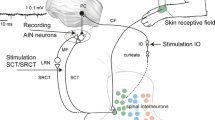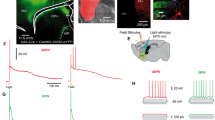Summary
We examined whether transient projections in the developing central nervous system of Mammalia form functional synapses on their target neurons, using transient ipsilateral interpositorubral (iIR) projection in kittens as a model system. Intracellular recordings were made from red nucleus (RN) neurons in 26 kittens aged 6–26 postnatal days (PD6-26). RN neurons were identified by monosynaptic excitatory postsynaptic potentials (EPSPs) evoked by stimulation of contralateral nucleus interpositus (IN), and additionally by intracellular staining in a few cells. Sixty-nine out of 362 RN neurons responded to stimulation of the ipsilateral IN. Of the 69 cells, 25 showed depolarizing responses with relatively short latency (2.1–6.7 ms) in kittens up to PD20. Such responses were not observed in older animals. Varying stimulus strength revealed that the potentials were unitary. Paired-pulse facilitation of the potential was observed, suggesting that the depolarizations are EPSPs. Several lines of evidence were obtained suggesting that the EPSPs are evoked monosynaptically. They followed high-frequency stimulation up to 50 Hz, and their latencies remained constant with varying stimulus strength. The latencies of ipsilaterally induced EPSPs were always longer than those of contralateral ones, evidence consistent with the longer course of ipsilaterally projecting axons than that of contralateral ones (Song and Murakami 1990). The age of disappearance of the monosynaptic EPSPs, i.e., PD20, also corresponds roughly with that of the anatomically demonstrable iIR fibers (PD15–PD25; Song and Murakami 1990). It is thus concluded that the transient iIR fibers in kittens form functional synapses on RN neurons.
Similar content being viewed by others
References
Armstrong DM (1988) The supraspinal control of mammalian locomotion. J Physiol (Lond) 405:1–37
Brown TH, Kairiss EW, Keenan CL (1990) Hebbian synapses: biophysical mechanisms and algorithms. Annu Rev Neurosci 13:475–511
Buchanan J, Sun Y-A, Poo M-M (1989) Studies of nerve-muscle interactions in Xenopus cell culture: fine structure of early functional contacts. J Neurosci 9(5):1540–1554
Campbell G, Shatz CJ (1992) Synapses formed by identified retinogeniculate axons during the segregation of eye input. J Neurosci 12:1847–1858
Changeux J-P, Danchin A (1976) Selective stabilisation of developing synapses as a mechanism for the specification of neuronal networks. Nature 264:705–712
Clarke PGH (1985) Neuronal death in the development of the vertebrate nervous system. Trends Neurosci 8:345–349
Constantine-Paton M, Cline HT, Debski E (1990) Patterned activity, synaptic convergence, and the NMDA receptor in developing visual pathways. Annu Rev Neurosci 13:129–154
Gorodnov VL, Fanardjian VV (1987) Functional properties of the cerebellorubral synapses in the cat. Brain Res 410:340–342
Hebb DO (1949) The organization of behavior. Wiley, New York
Horikawa K, Armstrong WE (1988) A versatile means of intracellular labeling: injection of biocytin and its detection with avidin conjugates. J Neurosci Methods 25:1–11
Innocenti GM, Fiore L, Caminiti R (1977) Exuberant projection into the corpus callosum from the visual cortex of newborn cats. Neurosci Lett 4:237–242
Jackson H, Parks TN (1982) Functional synapse elimination in the developing avian cochlear nucleus with simultaneous reduction in cochlear nerve axon branching. J Neurosci 2:1736–1743
Jeffery G, Arzymanow BJ, Lieberman AR (1984) Does the early exuberant retinal projection to the superior colliculus in the neonatal rat develop synaptic connections? Brain Res Dev Brain Res 14:135–138
Leonard CT, Goldberger ME (1987) Consequences of damage to the sensorimotor cortex in neonatal and adult cats. II. Maintenance of exuberant projections. Brain Res Dev Brain Res 32:15–30
Lichtman JW (1977) The reorganization of synaptic connexions in the rat submandibular ganglion cells during post-natal development. J Physiol (Lond) 273:155–177
Mariani J, Changeux J-P (1981) Ontogenesis of olivocerebellar relationships. I. Study by intracellular recordings of the multiple innervation of Purkinje cells by climbing fibers in the developing rat cerebellum. J Neurosci 1:696–702
Masuda Y, Suzuki Y (1981) Establishment of an experimental cat breeding colony. In: Nakano K, Maejima K (eds) The cat as an experimental animal (in Japanese). Soft Science, Tokyo, pp 100–107
Murakami F, Higashi S (1988) Presence of crossed corticorubral fibers and increase of crossed projections after unilateral lesions of the cerebral cortex of the kitten: a demonstration using anterograde transport of Phaseolus vulgaris leucoagglutinin. Brain Res 447:98–108
Murakami F, Saito Y, Higashi S, Oikawa H (1991) Synapses formed by ectopic corticofugal axons: an electron microscopic study of crossed corticorubral projections in kittens. Neurosci Lett 131:49–52
Panneton WM, Tolbert DL (1984) The collateral origin of a transient cerebrocerebellar pathway in kittens. A study using fluorescent double-labeling techniques. Brain Res Dev Brain Res 14:247–254
Purves D, Lichtman JW (1980) Elimination of synapses in the developing nervous system. Science 210:153–157
Purves D, Lichtman JW (1985) Rearrangement of developing neuronal connections. In: Purves D, Lichtman JW (eds) Principles of neural development. Sinauer, Sunderland, pp 271–300
Rakic P (1986) Mechanism of ocular dominance segregation in the lateral geniculate nucleus: competitive elimination hypothesis. Trends Neurosci 9:11–15
Redfern PA (1970) Neuromuscular transmission in new-born rats. J Physiol (Lond) 209:701–709
Shatz CJ (1990) Impulse activity and the patterning of connection during CNS development. Neuron 5:745–756
Shatz CJ, Kirkwood PA (1984) Prenatal development of functional connections in the cat's retinogeniculate pathway. J Neurosci 4:1378–1397
Song W-J, Murakami F (1990) Ipsilateral interpositorubral projection in the kitten and its relation to post-hemicerebellectomy plasticity. Brain Res Dev Brain Res 56:75–85
Song W-J, Kobayashi Y, Yamazaki M, Murakami F (1990) Regressive aberrant projections in the developing CNS of mammalia are functional (abstract). Neurosci Res [Suppl] 11:34
Sretavan DW, Shatz CJ (1986) Prenatal development of retinal ganglion cell axons: segregation into eye-specific layers within the cat's lateral geniculate nucleus. J Neurosci 6:234–251
Stanfield BB (1984) Postnatal reorganization of cortical projections: the role of collateral elimination. Trends Neurosci 7:37–41
Stanfield BB, O'Leary DDM, Fricks C (1982) Selective collateral elimination in early postnatal development restricts cortical distribution of rat pyramidal tract neurones. Nature 298:371–373
Stent GS (1973) A physiological mechanism for Hebb's postulate of learning. Proc Natl Acad Sci USA 70:997–1001
Tolbert DL, Panneton WM (1983) Transient cerebrocerebellar projections in kittens: postnatal development and topography. J Comp Neurol 221:216–228
Tsukahara N, Kosaka K (1968) The mode of cerebral excitation of red nucleus neurons. Exp Brain Res 5:102–117
Tsukahara N, Toyama K, Kosaka K (1967) Electrical activity of red nucleus neurons investigated with intracellular microelectrodes. Exp Brain Res 4:18–33
Tsukahara N, Fuller DRG, Brooks VB (1968) Collateral cortical influences on the corticorubrospinal system. J Neurophysiol 31:467–484
Tsukahara N, Fujito Y, Kubota M (1983) Specificity of the newly-formed corticorubral synapses in the kitten red nucleus. Exp Brain Res 51:45–56
Author information
Authors and Affiliations
Rights and permissions
About this article
Cite this article
Song, WJ., Kobayashi, Y. & Murakami, F. An electrophysiological study of a transient ipsilateral interpositorubral projection in neonatal cats. Exp Brain Res 92, 399–406 (1993). https://doi.org/10.1007/BF00229028
Received:
Accepted:
Issue Date:
DOI: https://doi.org/10.1007/BF00229028




